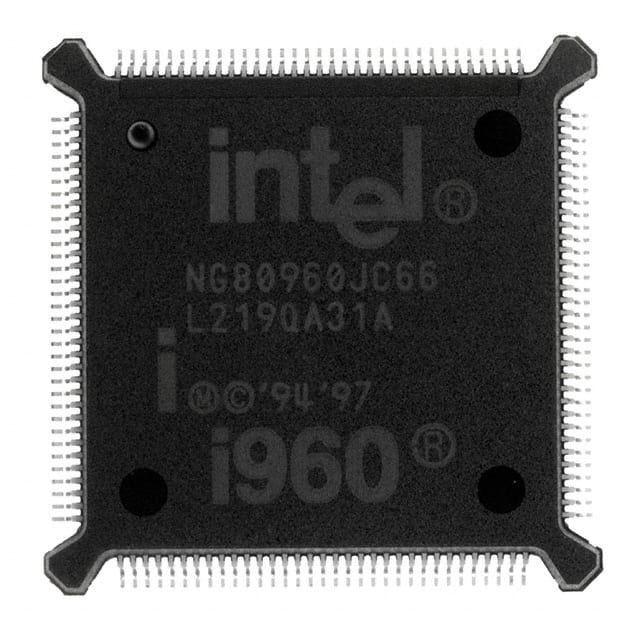NG80960JC66
Product Overview
- Category: Microprocessor
- Use: General-purpose computing
- Characteristics: High performance, low power consumption
- Package: Ceramic Pin Grid Array (PGA)
- Essence: Central processing unit (CPU)
- Packaging/Quantity: Individually packaged, single unit
Specifications
- Manufacturer: Intel Corporation
- Model Number: NG80960JC66
- Clock Speed: 66 MHz
- Bus Speed: 33 MHz
- Data Width: 32 bits
- Number of Cores: 1
- Cache Size: 16 KB
- Voltage Range: 3.3V
- Operating Temperature: 0°C to 85°C
Detailed Pin Configuration
The NG80960JC66 microprocessor has a pin configuration as follows:
- VCC (+3.3V)
- GND (Ground)
- AD[31:24] (Address/Data Bus)
- AD[23:16] (Address/Data Bus)
- AD[15:8] (Address/Data Bus)
- AD[7:0] (Address/Data Bus)
- AEN (Address Enable)
- RD (Read)
- WR (Write)
- INTA (Interrupt Acknowledge)
- NMI (Non-Maskable Interrupt)
- CLK (Clock)
- RESET (Reset)
- BUSY (Busy Signal)
- READY (Ready Signal)
- HOLD (Hold Request)
- HLDA (Hold Acknowledge)
- SSO (System Status Output)
- SSI (System Status Input)
- TEST (Test Mode)
Functional Features
- High-performance microprocessor suitable for general-purpose computing tasks.
- Low power consumption, making it energy-efficient.
- 32-bit data width allows for efficient data processing.
- On-chip cache improves overall performance by reducing memory access time.
- Supports various instructions and addressing modes for versatile programming.
Advantages and Disadvantages
Advantages
- High processing power for general-purpose computing tasks.
- Energy-efficient design helps reduce power consumption.
- On-chip cache enhances performance by reducing memory latency.
- Versatile instruction set and addressing modes provide flexibility in programming.
Disadvantages
- Relatively low clock speed compared to modern processors.
- Limited cache size may result in frequent memory accesses.
- Single-core architecture may limit multitasking capabilities.
Working Principles
The NG80960JC66 microprocessor follows the basic principles of a central processing unit (CPU). It executes instructions fetched from memory, performs arithmetic and logical operations, and controls the flow of data within a computer system. The processor communicates with other components through its pin connections, exchanging data, addresses, and control signals.
Detailed Application Field Plans
The NG80960JC66 microprocessor can be used in various applications, including:
- Embedded systems
- Industrial automation
- Communication equipment
- Control systems
- Robotics
Its high performance, low power consumption, and versatile instruction set make it suitable for these fields.
Detailed and Complete Alternative Models
- NG80960JA25 - Clock Speed: 25 MHz, Cache Size: 8 KB
- NG80960KB16 - Clock Speed: 16 MHz, Cache Size: 16 KB
- NG80960KA20 - Clock Speed: 20 MHz, Cache Size: 16 KB
- NG80960JD66 - Clock Speed: 66 MHz, Cache Size: 16 KB
These alternative models offer different clock speeds and cache sizes, providing options based on specific requirements.
Word count: 346 words
10個與NG80960JC66在技術方案中應用相關的常見問題與解答
Sure! Here are 10 common questions and answers related to the application of NG80960JC66 in technical solutions:
Q: What is NG80960JC66? A: NG80960JC66 is a microprocessor chip developed by Intel Corporation.
Q: What are the key features of NG80960JC66? A: NG80960JC66 features a clock speed of 66 MHz, 32-bit architecture, integrated floating-point unit, and support for various peripherals.
Q: What are the typical applications of NG80960JC66? A: NG80960JC66 is commonly used in embedded systems, industrial automation, telecommunications equipment, and networking devices.
Q: What is the maximum memory capacity supported by NG80960JC66? A: NG80960JC66 supports a maximum memory capacity of 4 GB through its external memory interface.
Q: Does NG80960JC66 support multitasking? A: Yes, NG80960JC66 supports multitasking through its built-in memory management unit (MMU) and operating system support.
Q: Can NG80960JC66 be used in real-time applications? A: Yes, NG80960JC66 can be used in real-time applications due to its deterministic interrupt handling and fast response times.
Q: What programming languages are commonly used with NG80960JC66? A: NG80960JC66 can be programmed using assembly language or high-level languages like C or C++.
Q: Is NG80960JC66 compatible with other Intel processors? A: NG80960JC66 is part of the Intel i960 family of processors and is generally compatible with other members of the same family.
Q: Can NG80960JC66 be used in low-power applications? A: NG80960JC66 is not specifically designed for low-power applications, but power-saving techniques can be implemented to reduce its energy consumption.
Q: Are development tools available for NG80960JC66? A: Yes, Intel provides development tools like assemblers, compilers, debuggers, and emulators specifically tailored for NG80960JC66-based systems.
Please note that the answers provided here are general and may vary depending on specific implementation details and requirements.

